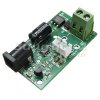I'll going to void the warranty on the Rigol DS1052E and change the fan.
There are quite a few articles on doing this.
One fan discussed is the Noiseblocker NB-Multiframe M8-S2 - 80mm case fan.
I can get it 'locally' for <17 Euros.
M8-S2 1700rpm 3 Pin 4.5 V / 12.0 V 15 dBA 47.0 m³
The fan I have already ordered is SKU040877 also known as AD0812XB-A73GP
Cost 2.58 Euros. Ships free from Hong Kong. Ordered from BangGood.com.
Voltage- 12V.
Voltage range- 6 to 13.8V.
Current- 0.21Amps.
Speed- 4500RPM at rated voltage and zero pressure.
Flow (max)- 67CFM.
Pressure Rise (Max)- 0.3inH2O.
Noise- 46dBA at rated voltage and zero pressure- measured at 1 meter to side.
I'm thinking if I use a series resistor I can slow this fan down to maybe 1700rpm
and get close to the same noise level and air flow as the Noiseblocker.
The stock fan:
"The factory mounted fan that came with my Rigol was a "GLOFN GFA06015H12H".
That is a 60x60mm running with 5500rpm @12V DC. According to the manufacturers
website it has an air flow of 34.2m3/h and makes 36.5dBA noise."
There is just enough room for an 80mm fan mounted away from the case grill.
Any thoughts?
There are quite a few articles on doing this.
One fan discussed is the Noiseblocker NB-Multiframe M8-S2 - 80mm case fan.
I can get it 'locally' for <17 Euros.
M8-S2 1700rpm 3 Pin 4.5 V / 12.0 V 15 dBA 47.0 m³
The fan I have already ordered is SKU040877 also known as AD0812XB-A73GP
Cost 2.58 Euros. Ships free from Hong Kong. Ordered from BangGood.com.
Voltage- 12V.
Voltage range- 6 to 13.8V.
Current- 0.21Amps.
Speed- 4500RPM at rated voltage and zero pressure.
Flow (max)- 67CFM.
Pressure Rise (Max)- 0.3inH2O.
Noise- 46dBA at rated voltage and zero pressure- measured at 1 meter to side.
I'm thinking if I use a series resistor I can slow this fan down to maybe 1700rpm
and get close to the same noise level and air flow as the Noiseblocker.
The stock fan:
"The factory mounted fan that came with my Rigol was a "GLOFN GFA06015H12H".
That is a 60x60mm running with 5500rpm @12V DC. According to the manufacturers
website it has an air flow of 34.2m3/h and makes 36.5dBA noise."
There is just enough room for an 80mm fan mounted away from the case grill.
Any thoughts?
Last edited:


